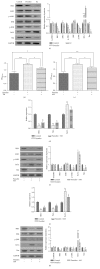Psoralen Inhibited Apoptosis of Osteoporotic Osteoblasts by Modulating IRE1-ASK1-JNK Pathway
- PMID: 28349059
- PMCID: PMC5352870
- DOI: 10.1155/2017/3524307
Psoralen Inhibited Apoptosis of Osteoporotic Osteoblasts by Modulating IRE1-ASK1-JNK Pathway
Abstract
Osteoporosis is a common disease causing fracture in older populations. Abnormal apoptosis of osteoblasts contributes to the genesis of osteoporosis. Inhibiting apoptosis of osteoblasts provides a promising strategy to prevent osteoporosis. The proliferation of osteoblasts isolated from osteoporotic patients or healthy subjects was determined by MTT assay. Apoptosis was determined by Annexin V/PI assay. Protein expression was measured by western blot. The proliferation of osteoblasts isolated from osteoporotic patients was inhibited and the apoptosis level of these cells was higher than the osteoblasts from healthy subjects. Incubation with psoralen or estradiol significantly enhanced the proliferation and decreased the apoptosis level of osteoporotic osteoblasts. Western blot demonstrated that psoralen or estradiol treatment downregulated the expression of IRE1, p-ASK, p-JNK, and Bax. Meanwhile, expression of Bcl-2 was upregulated. Pretreatment by IRE1 agonist tunicamycin or JNK agonist anisomycin attenuated the effect of psoralen on osteoporotic osteoblasts. Psoralen inhibited apoptosis of osteoporotic osteoblasts by regulating IRE1-ASK1-JNK pathway.
Conflict of interest statement
The authors declare that there is no conflict of interests regarding the publication of this paper.
Figures




Similar articles
-
Molecular Mechanisms of IRE1α-ASK1 Pathway Reactions to Unfolded Protein Response in DRN Neurons of Post-Traumatic Stress Disorder Rats.J Mol Neurosci. 2017 Apr;61(4):531-541. doi: 10.1007/s12031-017-0895-z. Epub 2017 Feb 16. J Mol Neurosci. 2017. PMID: 28210980
-
Paraquat activates the IRE1/ASK1/JNK cascade associated with apoptosis in human neuroblastoma SH-SY5Y cells.Toxicol Lett. 2009 Dec 15;191(2-3):203-10. doi: 10.1016/j.toxlet.2009.08.024. Epub 2009 Sep 6. Toxicol Lett. 2009. PMID: 19735704
-
[Mechanism of Xiangsha Liujunzi Decoction in improving autophagy in interstitial cells of Cajal of rats with functional dyspepsia by regulation of IRE1/ASK1/JNK pathway].Zhongguo Zhong Yao Za Zhi. 2025 Apr;50(8):2237-2244. doi: 10.19540/j.cnki.cjcmm.20241111.705. Zhongguo Zhong Yao Za Zhi. 2025. PMID: 40461233 Chinese.
-
SP600125 reduces lipopolysaccharide-induced apoptosis and restores the early-stage differentiation of osteoblasts inhibited by LPS through the MAPK pathway in MC3T3-E1 cells.Int J Mol Med. 2015 May;35(5):1427-34. doi: 10.3892/ijmm.2015.2130. Epub 2015 Mar 9. Int J Mol Med. 2015. PMID: 25760015
-
A Review of the Pharmacological Properties of Psoralen.Front Pharmacol. 2020 Sep 4;11:571535. doi: 10.3389/fphar.2020.571535. eCollection 2020. Front Pharmacol. 2020. PMID: 33013413 Free PMC article. Review.
Cited by
-
Psoralen Induces Developmental Toxicity in Zebrafish Embryos/Larvae Through Oxidative Stress, Apoptosis, and Energy Metabolism Disorder.Front Pharmacol. 2018 Dec 18;9:1457. doi: 10.3389/fphar.2018.01457. eCollection 2018. Front Pharmacol. 2018. PMID: 30618751 Free PMC article.
-
TRIM33 protects osteoblasts from oxidative stress-induced apoptosis in osteoporosis by inhibiting FOXO3a ubiquitylation and degradation.Aging Cell. 2021 Jul;20(7):e13367. doi: 10.1111/acel.13367. Epub 2021 Jun 8. Aging Cell. 2021. PMID: 34101965 Free PMC article.
-
Methylase METTL3 regulates oxidative stress-induced osteoblast apoptosis through Wnt/β-catenin signaling pathway.J Mol Histol. 2025 Feb 10;56(2):86. doi: 10.1007/s10735-025-10358-x. J Mol Histol. 2025. PMID: 39928245
-
Psoralen inhibits malignant proliferation and induces apoptosis through triggering endoplasmic reticulum stress in human SMMC7721 hepatoma cells.Biol Res. 2019 Jul 5;52(1):34. doi: 10.1186/s40659-019-0241-8. Biol Res. 2019. PMID: 31277690 Free PMC article.
-
Glycine represses endoplasmic reticulum stress-related apoptosis and improves intestinal barrier by activating mammalian target of rapamycin complex 1 signaling.Anim Nutr. 2022 Mar;8(1):1-9. doi: 10.1016/j.aninu.2021.05.004. Epub 2021 Sep 15. Anim Nutr. 2022. PMID: 34977370 Free PMC article.
References
MeSH terms
Substances
LinkOut - more resources
Full Text Sources
Other Literature Sources
Medical
Research Materials
Miscellaneous

